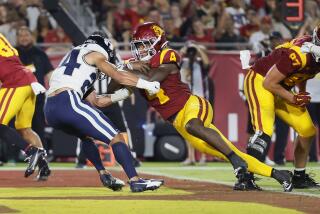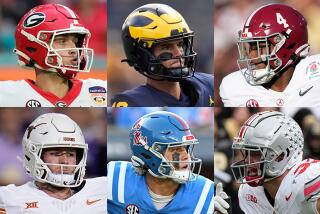These Are Sorry Times for Sooners
- Share via
Oklahoma, where the wins came sweeping down the Plains and the All-Americans fell out of feed trucks, is no longer a show stopper.
Oklahoma is not OK.
Oklahoma stinks.
A pillar in college football’s foundation, the Sooners are 0-3 for the first time since 1965 and have a chance to end up an unthinkable 0-11.
Oklahoma, a program that has bequeathed six national champions, 50 consensus All-Americans, the nation’s longest winning streak--47 consecutive games under Bud Wilkinson from 1953 to ‘57--is a laughingstock.
Greatness is so far removed there are 10-year-olds in Norman who have never heard of Brian Bosworth.
OK, so maybe that’s a good thing.
But three losses to Western Athletic Conference teams--Texas Christian, San Diego State and Tulsa--are not.
So much for the “easy” part of the schedule. Longtime Sooner watchers don’t see a “W” on the horizon with an upcoming Big 12 stampede: Kansas, at Texas, at Baylor, at Kansas State, Nebraska, at Oklahoma State, at Texas A&M;, Texas Tech.
Imagine Notre Dame going 0-11. Or Alabama. Or USC. Or Texas.
It could happen in Norman.
“I’ve never thought of 0-11,” first-year Coach John Blake said this week. “I think of winning each game, each week. I think about the next day of practice, what we’re going to accomplish. I don’t think that far down the road.”
What went wrong since the Sooners won their last national title under Barry Switzer in 1985 has been well chronicled.
Scandal rocked the program in the late 1980s with revelations of wild campus rampages involving firearms, sexual assault and general mayhem at the athletic dormitory known as Bud (Wilkinson) Hall. Two Sooners were convicted for rape; another was shot by a teammate in the dorm. Quarterback Charles Thompson was arrested for selling cocaine to undercover cops and ended up on the cover of Sports Illustrated in handcuffs. Thompson later wrote that Bud Hall was “24-hour revolving door of girls, students and strangers.”
Not exactly the three Rs.
Oklahoma was socked with three years of NCAA probation, and Switzer left after the ’88 season, replaced by a dour but saintly former Sooner, Gary Gibbs, who did everything right other than going 4-16-1 against Texas, Colorado and Nebraska.
Gibbs gave way last year to a rare outsider, Howard Schnellenberger, the Yosemite Sam-voiced relic who once led Miami and Louisville to acclaim.
Schnellenberger was Hurricane Fran, a windbag full of false bravado who, according to insiders, berated everyone in the administrative offices. His wife, Beverly, insisted everyone refer to her properly as “Mrs. Schnellenberger.”
That might have been tolerable had Oklahoma won eight or nine games. But after the Sooners finished 5-5-1, the team’s worst record in 30 years, Mr. and Mrs. Schnellenberger were shown the door.
The school then hearkened to its roots and hired, on Switzer’s arm-twisting recommendation, Blake, a true-blue former Sooner player who was a line coach on Switzer’s Dallas Cowboy staff.
At 35, Blake is the youngest Division I-A head coach in the country and the youngest on his staff. He inherited a freshman-sophomore laden team with nine returning starters, none on the offensive line, and an erratic sophomore quarterback in Eric Moore, whom Blake has already benched in favor of freshman Justin Fuente.
Some say the Oklahoma swoon is scandal residual, though insiders claim the fault has been in recruiting. Oklahoma is losing in-state players, which once would have been unfathomable, and hasn’t had an All-American since lineman Anthony Phillips in 1988.
Tennessee has five Oklahoma natives on its roster, Nebraska has three, including star safety Mike Minter. Michigan has one, as does Colorado.
Blake, who had no previous head coaching experience, will be responsible for evoking memories of home-grown Heisman winners--Steve Owens and Billy Vessels--and keeping Oklahomans at home.
“Tradition is always going to be here,” Blake says. “But what made the Sooners were the people that played on the football field. You don’t step on the field and become part of tradition.”
Blake will need time to turn recruiting around, and word is he will get it.
“Oklahoma’s coming back,” he insists.
Blake warns those who are reveling in Oklahoma’s pain.
“The giant is waking up right now and will continue to shake until we rise.”
TROY THE TAILBACK
Paul Hornung remains the only player in history to have won the Heisman Trophy playing on a losing team, winning the award for Notre Dame’s 2-8 team of 1956.
If any player since deserves to be the second, it’s Iowa State tailback Troy Davis. Forget records and common opponents and consider this fact:
Davis is a phenom.
Last year, he became the first player in history to rush for more than 2,000 yards (he gained 2,010) and not win the Heisman, finishing fifth as a sophomore on a 3-8 team.
Through four games this season, he’s leading the nation in rushing again, is on a 2,500-yard pace and coming off a two-game burst in which he has carried 94 times for 619 yards.
After rushing for 241 yards in 53 carries against Northern Iowa two weeks ago, Davis said, “I woke up, my body was aching, I got in the whirlpool, now everything’s straight again. I’m ready to play again.”
He wasn’t fooling.
Last Saturday, Davis rushed 41 times for 378 yards against Missouri, the third-highest total in NCAA history.
“There are so many things about Troy Davis that amaze us all the time,” his coach, Dan McCarney, says. “His resiliency, conditioning, durability. He felt great yesterday [Sunday] after 40 carries. He got a lot of gang tackling from Missouri, but he was ready to go, fresh as ever. He’s an amazing young man.”
In Iowa State’s 45-31 victory over Missouri, Davis gained 175 yards in 16 carries . . . in the fourth quarter.
For the season, he’s averaging 7.6 yards per carry and 229.2 yards per game.
Davis’ Heisman hopes, however, are probably tied to the fate of the Cyclones, 2-2 after winning consecutive games for the first time in 69 games.
“We’re trying to do all we can to bring national honor and respect to this program by winning football games,” says McCarney, in his second season after long stints as an assistant at Iowa and Wisconsin.
The bad news is Iowa State has yet to face the meat of its Big 12 schedule: Baylor, Kansas, Colorado, Nebraska and Kansas State.
Another losing season appears inevitable.
This time, it shouldn’t be held against Troy Davis.
DEFIANCE OF THE ALLIANCE
The Rose Bowl may not have to wait until 2002 to be host for the national championship game, one of the perks the “Granddaddy” received for joining the new “super alliance” in a deal completed in Chicago last week.
Have you checked out this week’s Associated Press poll?
After No 1. Florida and No. 2 Florida State lurks a four-team flotilla of “alliance busters” in No. 3 Ohio State, No. 4 Penn State, No. 5 Arizona State and No. 6 Michigan.
The deal to co-opt the Pacific 10 and Big Ten conferences into the “national championship” family does not take effect until after the 1998 season, meaning Sugar Bowl Executive Director Paul Hoolahan is already rationing perspiration.
“If you start sweating now, you won’t have a lot of sweat for later,” Hoolahan said from New Orleans this week.
Under the current rotating bowl arrangement, the Sugar Bowl has the rights to match the top two teams this year so long as neither is a member of either the Pac-10 or Big Ten, a pretty tenuous “so long as” as it stands now.
Understand why Hoolahan is nervous. There is no way Florida and Florida State can end up 1-2 and undefeated because the teams play each other Nov. 30 and there are no more ties in college football.
With three current unbeatens, the Big Ten has a decent shot of getting one team through unscathed, although Penn State, Ohio State and Michigan all face one another.
Even if all end up with a loss, Arizona State could mess up the Sugar Bowl’s one-two matchup if it ends up undefeated and ranked either first or second.
It is conceivable Arizona State and one of the three Big Ten schools could end up Nos. 1 and 2 and meet in the Rose Bowl for the national championship, knocking the Sugar Bowl in the bayou.
“There’s a lot of football to be played,” Hoolahan cautioned. “We continue to watch with a great deal of interest. Football is a strange game. There are no predictable outcomes.”
IT’S JUST PLAIN WACKY
San Diego State Coach Ted Tollner has a right to be miffed at the WAC’s decision to move his team’s Oct. 5 home game against Air Force to Nov. 28, Thanksgiving Day.
“I think the decision’s ridiculous,” Tollner said on this week’s WAC teleconference with reporters.
The game had to be moved because of a scheduling conflict with the San Diego Padres at Jack Murphy Stadium. Air Force refused to play the game on Friday, claiming a competitive disadvantage because the Aztecs had a bye last weekend while Air Force played Rice.
Now, however, San Diego State will have to face Air Force five days after playing Fresno State while Air Force is coming off a bye week.
“I don’t understand that kind of logic,” Tollner said.
HURRY UP OFFENSE
--OK, so maybe writers don’t know peanuts from pigskins when it comes to voting in the Associated Press poll, but they’re much more credible than the USA Today/CNN Coaches’ poll. For the second week in a row, the coaches have Nebraska (sixth) ranked ahead of Arizona State (seventh). That’s right, the same Arizona State that whacked Nebraska, 19-0, in a celebrated Sept. 21 game the voting coaches may have read about in USA Today.
--Welcome to the bigs: Tim Couch, Kentucky’s heralded freshman quarterback, made his first start in Saturday’s 65-0 loss to Florida and was intercepted on his first pass.
--Have nots versus haves report: The WAC is 6-5 against “superconference” Big 12, but only 1-8 against the Pac-10. The Pac-10 is 17-8 against nonconference opponents.
More to Read
Go beyond the scoreboard
Get the latest on L.A.'s teams in the daily Sports Report newsletter.
You may occasionally receive promotional content from the Los Angeles Times.











